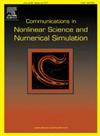On equilateral central configurations in the 1+4-body problem
IF 3.8
2区 数学
Q1 MATHEMATICS, APPLIED
Communications in Nonlinear Science and Numerical Simulation
Pub Date : 2025-09-26
DOI:10.1016/j.cnsns.2025.109365
引用次数: 0
Abstract
We investigate central configurations in the planar five-body problem with one dominant mass. The remaining four masses, referred to as coorbital satellites, are infinitesimal and positioned along a circle centered at the big mass. We focus on stacked relative equilibria in which the central body and two fixed satellites form an equilateral triangle, while the two remaining satellites occupy distinct positions on the unit circle. In the limiting case when the small masses tend to zero, the problem naturally divides into three scenarios depending on the location of these remaining bodies relative to the arc formed by the two fixed satellites. We show that the first case, in which both satellites lie inside the arc, cannot occur under the positivity constraint on the masses. The second case, where one satellite lies inside the arc and the other outside, admits solutions that we characterize in detail, while the third case, with both satellites outside the arc, leads to a richer family of admissible configurations.
1+4体问题中的等边中心构型
研究了具有一个优势质量的平面五体问题的中心构型。剩下的四个质量,被称为共轨卫星,是无限小的,沿着一个以大质量为中心的圆圈定位。我们关注的是中心体和两个固定卫星形成一个等边三角形的堆叠相对平衡,而剩下的两个卫星在单位圆上占据不同的位置。在小质量趋于零的极限情况下,根据这些剩余物体相对于两颗固定卫星形成的弧线的位置,问题自然分为三种情况。我们证明了第一种情况,即两个卫星都在圆弧内,在质量的正约束下不可能发生。第二种情况,其中一个卫星在弧线内,另一个在弧线外,允许我们详细描述的解决方案,而第三种情况,两个卫星都在弧线外,导致更丰富的可接受配置族。
本文章由计算机程序翻译,如有差异,请以英文原文为准。
求助全文
约1分钟内获得全文
求助全文
来源期刊

Communications in Nonlinear Science and Numerical Simulation
MATHEMATICS, APPLIED-MATHEMATICS, INTERDISCIPLINARY APPLICATIONS
CiteScore
6.80
自引率
7.70%
发文量
378
审稿时长
78 days
期刊介绍:
The journal publishes original research findings on experimental observation, mathematical modeling, theoretical analysis and numerical simulation, for more accurate description, better prediction or novel application, of nonlinear phenomena in science and engineering. It offers a venue for researchers to make rapid exchange of ideas and techniques in nonlinear science and complexity.
The submission of manuscripts with cross-disciplinary approaches in nonlinear science and complexity is particularly encouraged.
Topics of interest:
Nonlinear differential or delay equations, Lie group analysis and asymptotic methods, Discontinuous systems, Fractals, Fractional calculus and dynamics, Nonlinear effects in quantum mechanics, Nonlinear stochastic processes, Experimental nonlinear science, Time-series and signal analysis, Computational methods and simulations in nonlinear science and engineering, Control of dynamical systems, Synchronization, Lyapunov analysis, High-dimensional chaos and turbulence, Chaos in Hamiltonian systems, Integrable systems and solitons, Collective behavior in many-body systems, Biological physics and networks, Nonlinear mechanical systems, Complex systems and complexity.
No length limitation for contributions is set, but only concisely written manuscripts are published. Brief papers are published on the basis of Rapid Communications. Discussions of previously published papers are welcome.
 求助内容:
求助内容: 应助结果提醒方式:
应助结果提醒方式:


